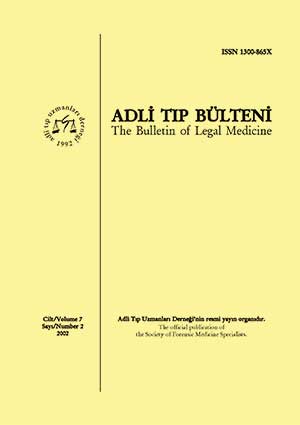Resuscitation Artefacts in Forensic Autopsies
DOI:
https://doi.org/10.17986/blm.200381487Keywords:
forensic autopsy, cpr, artefactual lesions, malpractice, shaken baby syndromeAbstract
Differentiation of the antemortem, postmortem, artefactual and perimortem lesions secondary to medical interventions is a challenging task during the forensic autopsies. In this study, forensic autopsy records, performed in Istanbul between 1998-2002, were reviewed retrospectively and the cases with a resuscitation history and presenting lesions corresponding to the resuscitation were included. The location and the fetaures of the lesions, the problems arising from them were analyzed and discussed. 11.7%(n:51) of resuscitated cases had multiple rib or sternum fractures with or without bruising and 4.2%(n:19) had only bruise. Fractures were found rarely on left 3.,4. and 5. ribs from mid-clavicular line. Sternum fractures were found, with or without bruising in 3.9% (n: 17) of resuscitated cases.
Key words: Forensic autopsy, CPR, artefactual lesions, malpractice, shaken baby syndrome.
Downloads
References
Knight B. Forensic Pathology. Second edition. New York: Oxford University Press Inc., 1997: 13, 37,38,41- 43.
Soysal Z, Eke M, Çağdır AS. Adli Otopsi (Cilt II). Birinci Baskı.İstanbul: 1st. Unv. Basımevi ve Film Merkezi, 1999: 675-677.
Raven KP, Reny D, Harmff RC. Artifactual injuries of the larynx produced by resuscitative intubation. J Forensic Med Pathol, 1999;20(l):31-36 DOI: https://doi.org/10.1097/00000433-199903000-00008
Polat O. Adli Tıp. Istanbul: Der Yayınları, 2000: 478-91.
Fitchet A., Neal R., Bannister P.. Splenic trauma complicating cardiopulmonary resuscitation. BMJ, 2001; 322: 480-81. DOI: https://doi.org/10.1136/bmj.322.7284.480
Odom A, et al. Prevalance of retinal hemorrhages in pediatric patients after in-hospital cardiopulmanary resuscitation. Pediatrics, 1997; 99(6):e3 DOI: https://doi.org/10.1542/peds.99.6.e3
Krischer JP, Fine GE, Davis JH, Nagel EL. Complications of cardiac resuscitation. Chest, 1987; 92(2):287-291. DOI: https://doi.org/10.1378/chest.92.2.287
Baubin M, Sumann G, Rabl W, Eibl G, Wenzel V, Mair P. Increased frequency of thorax injuries with ACD- CPR. Resuscitaton, 41(1999):33-38. DOI: https://doi.org/10.1016/S0300-9572(99)00033-7
Stone BJ, Chantier PJ, Baskett PJF. The incidence of regurgitation during cardiopulmanary resuscitation: a comparison between the bag valve mask and laryngeal mask airway. Chest, 1998;38:3-6.
Machii M, et al. Cardiac mpture by penetration of fractured sternum: a rare complication of cardiopulmonary resuscitation. Resuscitation, 2000;43: 151-153. DOI: https://doi.org/10.1016/S0300-9572(99)00137-9
Kern KB, Carter AB, Showen RL, Voorhees WD. 3rd ed. Babbs CF, Tacker WA, Ewy GA. CPR-induced trauma: comparison of three manual methods in an experimental model. Ann Emerg Med 1986;15(6):674-679. DOI: https://doi.org/10.1016/S0196-0644(86)80424-3
Dunkley CJA, Thomas AN, Taylor RJ, Perkins RJ. A comparison of standard and a modified method of two resuscita- tor adult cardiopulmonary resuscitation: Description of a new system for research into advanced life support skills. Resuscitation 1998 ;38: 7-12. DOI: https://doi.org/10.1016/S0300-9572(98)00071-9
The 1998 Europe Resuscitation Council guidelines for adult advanced life support. BMJ, 1998;316:1863-1869. DOI: https://doi.org/10.1136/bmj.316.7148.1863
Rabl W, Baubin M, Haid C, Pfeiffer KP, Scheithauer R. Review of active compression-decompression cardiopulmonary resuscitation (ACD-CPR). Analysis of iatrogenic complications and their biomechanical explanation. Forensic Sei Int. 1997 ;89:175-183. DOI: https://doi.org/10.1016/S0379-0738(97)00120-5
Rabl W, Baubin M, Broinger G, Scheithauer R. Serious complications from active compression-decompression cardiopulmonary resuscitation. Int J Legal Med. 1996;109(2):84-89. DOI: https://doi.org/10.1007/BF01355522
Yalçınkaya İ, Sayir F, Kurnaz M, Çobanoğlu U. Göğüs travması: 126 olgu analizi. Ulus Travma Derg. 2000;6(4):288-291.
Price EA, Rush LR, Perper JA, Bell MD. Cardiopulmonary resuscitation-related injuries and homicidal blunt abdominal trauma in children. Am J Forensic Med Pathol. 2000;21 (4):307-310. DOI: https://doi.org/10.1097/00000433-200012000-00001
Sperry K. Anterior thoracic wall trauma in elderly homicide victims. The "CPR defense". Am J Forensic Med Pathol. 1990;ll(l):50-55. DOI: https://doi.org/10.1097/00000433-199003000-00006
Conway Jr EE. Nonaccidental head injury in infants: “The shaken baby syndrome revisited". Pediatric Annals 1998;27(10):677-691. DOI: https://doi.org/10.3928/0090-4481-19981001-11
Bush CM, Jones JS, Cohle SD, Johnson H. Pediatric injuries from cardiopulmonary resuscitation. Ann Emerg Med. 1996;28(l):40-44. DOI: https://doi.org/10.1016/S0196-0644(96)70137-3
Lau G. A case of sudden maternal death associated with resuscitative liver injury.Forensic Sei Int. 1994;67(2):127- 132.
Lau G. A rase at sudden maternal death associated with resuscitative liver injury. For sei Ind, 1994; 67(2); 127.132 DOI: https://doi.org/10.1016/0379-0738(94)90327-1
Downloads
Published
Issue
Section
License
The Journal and content of this website is licensed under the terms of the Creative Commons Attribution (CC BY) License. The Creative Commons Attribution License (CC BY) allows users to copy, distribute and transmit an article, adapt the article and make commercial use of the article. The CC BY license permits commercial and non-commercial re-use of an open access article, as long as the author is properly attributed.

